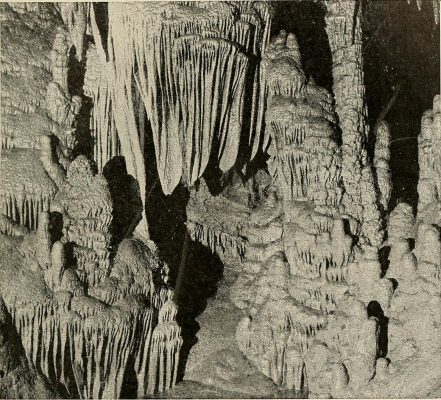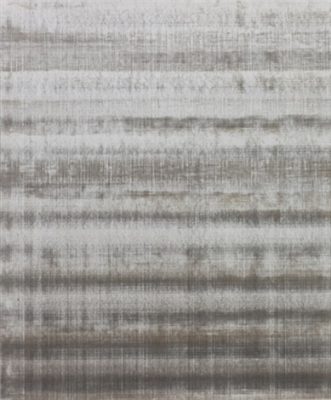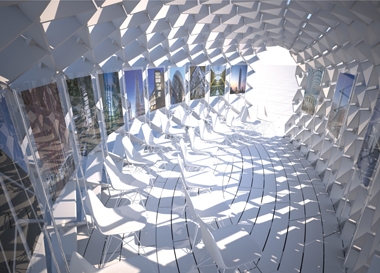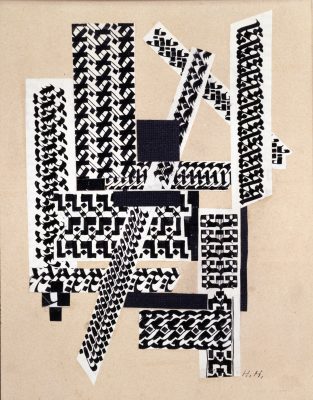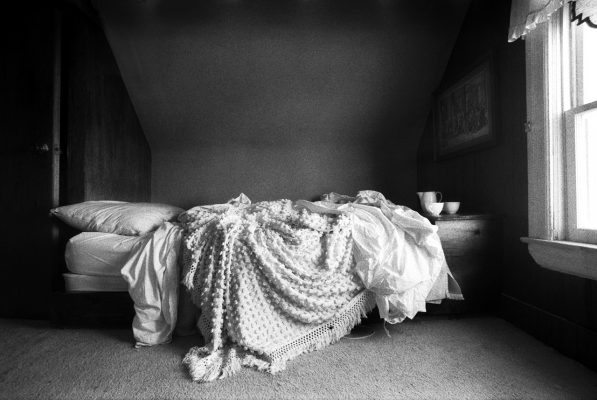Caves, sleep, absence of light
1.
Oh what is
this light that
holds us fast?
Frank O’Hara [1]
I was about to move house and the move was happening very quickly. My new home was just four miles east but I was leaving the part of London where I’d been born and had lived for most of my life. Although the reasons for moving were happy ones, I hadn’t anticipated the level of unsettlement it would bring about. One day, feeling overwhelmed by the detail of it all, I decided that what I really needed was to live alone in a cave. I was walking past a cinema and went into whatever was showing just to be able to sit in the dark. It was a film about a cave.[2]
The Chauvet Cave was discovered in 1994. It had long ago been sealed off by rockfall, leaving its 32,000-year-old paintings perfectly preserved. The pale walls are covered in bison, horses, rhinoceroses, lions and bears. They are strikingly fluid – a lion’s profile is given in a single six-foot-long stroke – but the artist has done even more to bring them alive. The cave is full of outcrops and recesses, the walls ripple and dip, and the animals have been drawn accordingly. One bison has been given eight legs and a rhinoceros a series of six horns to indicate, like a series of frames, that they are moving. I was in a cave that was a cinema watching a film about a cave that was a cinema.
The archaeologists and historians mapping and researching the cave had the open mind, and open imagination, that perhaps comes from operating so far beyond the human scale. One said that he dreamt of lions. ‘Real lions or painted lions?’ ‘Both.’ He sounded surprised to be asked to make the distinction. Another tried to explain how the world might have been perceived 32,000 years ago, describing an everyday condition of metamorphosis: ‘A tree can speak … a wall can talk to us, refuse or accept us.’
In the cinema – a place of talking walls – we forget where we are and observe where we aren’t. It’s a brief but powerful form of exemption like that of St Jerome in his cave. The distant world seems wonderfully clear but this clarity depends on how it has been framed by darkness. Here, the frame of the cave overwhelms the image as it does Jerome, who dissolves into it just as we dissolve when watching a film.
I was outside the world as it was now conjured and so safe to accept the presence of lions of any kind. I was in perfect relation to a framed and lit experience that I could explore but didn’t have to enter into. I was held fast by the light because it held me in place in the dark.
Yet the cinema is ‘cruel like a miracle’, as Frank O’Hara says. It overpowers and obliterates, compels our desires and fools us into ‘loving a shadow and caressing a disguise’.[3] Like all images, cinema is a way of testing connection, a rehearsal of contact that can be deadening or disturbing, but a point of triangulation with the actual, a way of creating a frame, or framework, that we seem to need.
2.
Down the one path …
Rilke, ‘Orpheus.Eurydike.Hermes’ [4]
To come across a cave where you don’t know one to be is like discovering a secret. The unexpected rupture draws you in.
There is a consistency to walking along a sea shore. We tend to do it in a straight line, from end to end, or one point to the next, channelled between cliffs on one side and water on the other. A cave is an interruption and a release. As a child wandering along the beach or beside a river, I would be looking for drama: not so much for something to happen as for something to mean something. I’d always enter a cave but not go so far into it that I couldn’t see its entrance. The point was being in the dark but able to see the light, and for the lit world to notice that I was gone and to come looking.
I was in Slovenia when my hosts suggested that we visit some caves. They were casual enough about the idea for me to envisage nothing more than a series of the minor darknesses I knew from childhood. Almost half of Slovenia sits on karst, bedrock perforated by water. There are about 10,000 caves and I was about to enter one of the largest cave systems of this type not only in the country but in the world.
We walked along a river, which suddenly folded itself away below rock. Then we too were folded away, entering a tunnel just big enough not to feel like one. It was gently and consistently lit, and in order not to panic I focused on that consistency. Everyone else was relaxed, the guide offhand, nothing was going to happen. I concentrated on fooling my body into accepting where it was – not moving away from the world, just following its reach down a well-made path.
My memory is that we were on that gently descending path for an hour but I found out later that it’s only about 400 feet long. The slowness was in the time it took for me to adjust to the unfolding scale of this journey and my need to keep re-making the decision that I was not going to turn back, which had the effect of returning me in my mind to the start.
As we passed into a cavern the size of a small church, I looked back at the lit tunnel to remind myself that I could leave whenever I wanted to. At that moment the guide shut a door (There was a door?) behind us. In my mind, the tunnel rolled itself up and snapped back into the earth. I set myself visual distractions, moving from one rock formation to the next, peering closely so as to keep my peripheral vision vague. If I couldn’t see a ceiling of rock over my head then there wasn’t one.
If there had been painted lions, I might have been able to forget where I was. Instead there were columns and accumulations which looked as if they were being continuously and infinitesimally forced into shape. In even the most eroded form, I insisted on finding something familiar, discerning gods and monsters in the slightest detail. It was like looking at deep-sea creatures and refusing them their strangeness.
There is an exact point at which I find a space too small or too crowded to remain there. My body makes a calculation to do with room to move and ways to leave, and its decision is absolute. I have climbed an enclosed spiral staircase in a tower without concern only for the walls to contract a couple of inches making it impossible for me to continue. The tunnel had been just large enough and this cavern’s spaciousness was a relief but I kept turning towards that door.
The guide then turned off the lights. The darkness was so substantial that I felt as if I could lean against it. It was more than air and less than solid, more like texture or pressure, a form of touch. I felt it on my skin rather than my eyes, and its effect was to make me give up my body. I wasn’t anxious anymore but consoled and released.
The lights went back on and I waited for the door to be opened only it wasn’t. This was just the start of the journey. We walked on through a series of caves and I found that my fear had been altered by that moment in the dark. My senses had loosened to such an extent that my usual calibrations couldn’t be carried out. I didn’t know now how large or small a space I entered, or how far I had walked or for how long. It wasn’t that this didn’t matter. It didn’t occur.
We walked under a river. I stood below its bed listening to the force of the water and the river was as clear to me as if I had seen it. We ended up on a precarious path of wooden planks high on the wall of the underground canyon that brought that river back above ground. We made our way back towards the light, as if through an aperture, reconstituted, redeveloped, re-fixed.
3.
When we know the full extent of any danger, when we can accustom our eyes to it, a great deal of apprehension vanishes.… [5]
As a child I spent a lot of time lying awake in the dark. When my light was turned off, I would close my eyes in a performance of sleep. In time it became actual sleep but meanwhile I’d open my eyes again and look at (rather than into) the dark. Night was a condition I was obliged to accept, as inexorable as weather or a feeling. It meant stillness, silence and self-reliance. It was also a space to think in.
What does a child remember before they can name what they see? Whatever stays in place and so repeats itself? My earliest memory is of night and two shapes within it: the concentration of detail that was the corner of a picture and the long fall of a curtain. I later moved to a room at the back of the house. Part of a sunken extension, it had small windows close to ground level. Daylight did not press in. There were no cracks or stains to animate, no recess or ornament. Nothing cast shadows or made the curtains ripple. There were no passing headlights, no lighthouse beam, no silhouettes of rattling branches. It was neither cinema nor cave but plain black box.
I played with the dark, not populating it with stories or characters but taking advantage of its freedom from visual laws, conjuring a world – the real world – in which the scale of things was infinitely adjustable and myself within it. I rearranged cities or set up home under a leaf.
The summer I turned eleven, I was camping in Scotland when we were taken into a wood after dark to play the Night Game. We were divided into two teams and had a piece of wool tied around our upper arms. This was your ‘life’. The teams then set off to opposite sides of a wood. The objective was to reach the other team’s home with your ‘life’ intact. Beyond that, you were on your own.
The wood was large enough to swallow forty people. As everyone scattered, I found myself alone, hearing the game already being played out in bursts of noise – a scuffle or crash, shouts, laughter. I barely registered being caught and having my life taken. What gripped me was being out in the woods at night and left to my own devices. I wasn’t scared because this wasn’t night but the Night Game, and I was sure of its full extent.
I remember the tiny hooks that caught at my hair and hands, bushes like low blue clouds, the shit-stink of unearthed rot, and the mucus veneer on the roots I grabbed as I slid down a steep slope. I remember this wood as every wood. The ground was hard wax or black squelch or dust. I waded through dead leaves and hid among green ones.
To invent a game is to furnish emptiness. Even as adults this is how we furnish our lives – with denials and permissions, procedures and codes. We accustom our eyes through expectation and experience, as if learning our way around a dark wood.
4.
Night came out of emptiness just like everything else – life, earth, impulse. Night was born of Chaos and married Darkness. Their children included Sleep and Death (but also Light and Day).[6] From Night came consequence: death, pain, woe – the things that happen when we can’t or don’t want to see.
A seventeenth-century print of Night caught my eye because of its colours: the drab olive and buff of the mind running on empty. It was Hendrik Goltzius’s Nyx and it looked as crushingly humdrum as the fifth sleepless night in a row feels. [7] Night is perched at the front of a chariot being drawn across a cloud. She’s naked except for a piece of cloth barely caught on her shoulders. The effect is not erotic but of someone on auto-pilot. Night is inevitable and when you can’t sleep, or aren’t allowed to, it can feel as if the world is turning while you stand still.
There is, then, something which is always moved with unceasing motion, which is motion in a circle; and this is plain not in theory only but in fact.[8]
Aristotle
This is the ur-routine – night following day. She seems indifferent to the blazing torch in her hand or the direction of travel. In the back of her charabanc, Sleep is portrayed as a woman slumped on one elbow, still wearing her garland, like an over-dressed and battle-weary teenage girl going home in a cab in the small hours.
Night lived in a cave, as did her son Sleep. She produced oracles while he lay on a couch as the river of forgetfulness flowed past and his children brought him dreams. One son collected dreams of people, one those of animals and one of things. So night and sleep lived in places of suspension and withdrawal where the world arrived in categories of images – like a series of woodcuts perhaps.
Goltzius is a better artist than this picture suggests but Nyx is one of a series of prints and his approach seems as routine as the scene feels. It’s a worn-out copy of an exhausted idea, which makes it so apt as an image of insomnia. Another night, another day, moving and not moving through the grey perpetual.
Consider what night meant in 1600 beyond the lantern in your hand, the fire in the hearth, the candle by your bed. The darkness that surrounds a light has substance and presence but that is my conception of darkness from a well-lit world. Walk into the dark and it starts to break down. Night would have been both more absolute and more accessible, moonlight less decorative and more of a practical necessity.
5.
I don’t feel as if I stop looking when I’m in absolute darkness.
Some of what you’re looking at is non-existent internal events.[9]
Even in a cave it takes a while for darkness to become really dark. The photopigments in our eyes that react to light and communicate its presence to the brain have been bleached and take a while to reset themselves. This is why when you close your eyes, you catch an after-image of whatever you were just looking at. The process of ‘dark adaptation’ takes about half an hour, by which time those pigments are empty of light and sensitised to respond to what little of it they can. In what first seemed like total darkness, we can now make out furniture, stalactites, a hedgerow, a gilded ceiling or gleam of water.
We also see light that isn’t there.[10] Photopigments have to be sensitive to the point of instability which means that sometimes they react at random and the brain sees light where there is none.
You’ll like it because it is poetic: the technical term is dark light.
It pleases me that dark light corrects the thing it names but it is also one of those scientific terms that writes its own poem and so should be left to its own poetic devices. Such terms are irresistible to those looking for a placeholder for meaning – another form of seeing light that isn’t there.[11]
Dark light was originally named in German, Eigengrau or Eigenlicht, ‘own grey’ or own light’, and is now more usually known as ‘visual noise’. So we are not seeing darkness when we look at the dark but noise. Nor are we seeing all we see. The brain sets itself limits so as to tune some of this dark light, grey light, own light out. We may be capable of detecting a flash of light as small as one photon but we only register a flash larger than around five.
The obvious thing that happens in the dark is that we rely more on our other senses, particularly on what we can hear.
You start to discover information which is present in your other senses, which you’re not normally aware of.
If you are blind, hearing becomes a way of reading the visual world. John Hull recorded the experience of going blind as a kind of spatial collapse.[12] He also described how the sound of rain could recover that space, giving him a physical sense of his surroundings. Using the ‘regularities and irregularities’ of sound, he can build up a visual picture out of the ‘drumming staccato’ of rain on metal, the ‘deeper, duller impact on brick or concrete’ and how the ‘note being struck’ differs from one window pane to another. He describes how this way he can build a picture that extends almost to the neighbouring houses.
As well as reliance on hearing, sudden darkness prompts a more subtle perceptual adjustment. Although we describe our senses separately, most of the time they are working in synthesis. The isolated sense depends far more on what we already know. If you’re in a cave, you hear that dripping sound as moisture falling from a stalactite rather than a tap someone’s forgotten to turn off.
In the dark are we visually active or passive, are we seeing or looking?
I don’t know if that translates into a scientific question. If it’s in the dark, how can we be seeing anything.
What I mean is are my eyes actively engaging with the darkness?
This is very poetic.
When we enter the dark, we start to imagine. Is this because of the emphasis our brain is putting on memory? Is the imagination just something thrown together from what we already know to make up for a lapse in perception? Does this help us activate memory and imagination?
Pass on that. I don’t think the data exists.
My interest is in what all this tells us about how we receive the world. The scientist is more interested in how we process it.
What about metaphorical darkness. Do you ever feel yourself moving into the unknown or is your work always at a point of logical progression?
The best of science is both things. Very rarely do scientists just take a stab at something without having given any thought to it, without there being any precedent. In the lab you wouldn’t say ‘Why don’t we just put this and that together and see what it does?’
Any more than I would sit down and say I think I’ll write a poem.
There’s always a background. We’re driven by hypotheses. That’s the way brains are made to work: what am I looking at – a tree or a person?
We rely on the integration of the senses yet we can discriminate with total confidence between something seen, heard, tasted, touched or smelt. The brain receives apparently identical impulses from our eyes and ears but we somehow know whether we’ve seen or heard.
We can discern this so acutely that it extends to stimuli we’re barely aware of and possibly those of which we’re unaware. How do we do this and why do we need to?[13] These as yet unanswered questions bring us back into the dark.
Science is at its best when the data departs from your expectations but in consistent and meaningful ways, and you suddenly begin to see a different interpretation emerging.
If we open up the question of what happens when we can’t see, we find within it further questions sitting one inside the other. What is it that we still see? What are the limits of vision? Why are there limits at all?
6.
When a boar comes, the stream does not swell by degrees, as at other times, but rolls in with a head … foaming and roaring as thought it were enraged by the opposition which it encounter.
Thomas Harrel, 1824
I stood on the edge of the River Severn at midnight, waiting for a twelve-foot-high wave to roar past in the wrong direction, a phenomenon called a tidal bore. Before I saw the wave coming, I heard it, and before that I felt a strange silence fall, a profound lapse in the atmosphere as the background rustle and murmur among the trees fell away.
The Severn Bore is one of the biggest in the world. When the tide comes into the Estuary, it is forced into an increasingly narrow channel. About twice a month, the tide is moving faster than the water further inland can flow and the pressure of this creates a large wave, called a bore, which travels miles at great speed before wearing itself out. At an equinox, the sun is at its closest to earth and so increases the gravitational pull of the moon, when they are aligned, and the tides are all the more extreme.
The Severn Bore sounds as if someone has unpinned the world and it’s rolling itself up very fast towards you. For what seemed like a long time, but was probably less than a minute, all I could do was try to make sense of this noise. It started as grain rushing into a silo, then scree tumbling down a mountainside, then buildings falling and finally an abstract state of monumental collapse. The sight of the wave when it finally appeared had far less impact.
Had I stood by the river in daylight and seen the wave coming, I doubt my reaction would have been as strong. It was the dislocation of my senses, the sudden reliance on hearing that moving into the dark brings, that made the experience so acute. I remember the experience as one of sound rather than vision, and as sound I felt rather than heard. It was as if the wave had travelled through rather than past me.
7.
For though great light be insufferable to our eyes,
yet the highest degree of darkness does not at all disease them.
John Locke[14]
We don’t want absolute light, after all it blinds us. But absolute dark can be something we crave. Boundless, it sensitises us to the present moment. We can neither look back nor see ahead. It is an escape from memory and anticipation, and to that extent an escape from ourselves.
We’re used to thinking of light as a tool for knowledge but darkness is one too as we test what we know against what we don’t. Any insight arrives together with a realisation that the more you know, the more there is to know. It is as if the proportion of darkness stays constant to the proportion of light.
This figurative light and dark translate back into the physical world. The lights go on and the darkness grows. In both senses, we enter the dark less and less, and forget how to move through it, thinking the lit path the safest route when it exposes us and disables our vision.
Darkness is something we always feel on the edge of or about to enter. In this way, it reminds us that we are our starting point and out there is possibility. There is always more to see, and more to see in ourselves, whether we choose to or not.
I’ll have that light next to the street dammed up.
It gives too full a prospect to temptation
And courts a gazer’s glances. There’s a lust
Committed by the eye, that sweats, and travails,
Plots, wakes, contrives, till the deformed bear-whelp
Adultery be licked into the act,
The very act. That light shall be dammed up.[15]
Notes
[1] From ‘An Image of Leda’, Frank O’Hara
[2] Werner Herzog, The Cave of Forgotten Dreams, 2011
[3] From ‘An Image of Leda’
[4] ‘Und dieses einen Weges kamen sie.’
[5] Edmund Burke, On the Sublime and the Beautiful, Part II, Section iii, ‘Obscurity’, pp. 102-3.
[6] Nyx and Erebus brought forth Hemera – Day (Hesiod Theogony 120-125)
[7] The Greek goddess of night, in Latin called Nox
[8] Aristotle, Metaphysics, Book 12, Part 7
[9] This section draws on a conversation with the neuroscientist Professor Colin Blakemore, Institute of Philosophy, University College London.
[10] Our brain can also hear what isn’t there. Brain scans taken of people looking at an image of a barking dog showed that the auditory area of the brain had been activated.
[11] Dark Light has been used as an album title by Gary Numan and East 17, and as a book and play title. Eigengrau is an album by Section 25.
[12] John M. Hull, Touching the rock: an experience of blindness, (London: SPCK, 1990).
[13] An area of research currently being undertaken by Professor Blakemore and his team at UCL.
[14] John Locke, An Essay Concerning Human Understanding, Book 2, c.4, 131
[15] John Ford, The Broken Heart, II.i
